
About UsThe Numismatic Bibliomania Society is a non-profit organization promoting numismatic literature. For more information please see our web site at coinbooks.org SubscriptionsThose wishing to become new E-Sylum subscribers (or wishing to Unsubscribe) can go to the following web page link MembershipThere is a membership application available on the web site Membership Application To join, print the application and return it with your check to the address printed on the application. Membership is only $15 to addresses in the U.S., $20 for First Class mail, and $25 elsewhere. For those without web access, write to: David M. Sundman, Secretary/TreasurerNumismatic Bibliomania
Society AsylumFor Asylum mailing address changes and other membership questions, contact David at this email address: dsundman@LittletonCoin.com SubmissionsTo submit items for publication in The E-Sylum, just Reply to this message, or write to the Editor at this address: whomren@coinlibrary.com
BUY THE BOOK BEFORE THE COINYou won't regret it! |
- WAYNE'S WORDS: THE E-SYLUM OCTOBER 24, 2010
- UPDATE: COIN BOOK IMAGES FOR NBS BIBLIOGRAPHY
- DAVIS SALE OF DAVISSON AND HODDER MATERIAL CLOSES OCTOBER 30, 2010
- SKLOW TO OFFER BOWERS LIBRARY PART IV ON FEBRUARY 12, 2011
- NEW BOOK: AMERICAN ART MEDALS, 1909–1995
- NEW BOOK: 1824 JR-2 - THE 6TH RAREST CAPPED BUST DIME DIE VARIETY
- NEW EDITION: A CATALOG OF MODERN WORLD COINS, IN JAPANESE
- BOOK REVIEW: MONEY ON PAPER: BANK NOTES AND RELATED GRAPHIC ARTS
- MORE ON THE 1852 ORMSBY SOLD BY SPINK
- BOUND FOR GLORY: EXOTIC BINDINGS IN THE ANS LIBRARY COLLECTIONS
- CREATE YOUR OWN WEB SITE ON YOUR COLLECTING TOPIC
- DAVID LANGE ON HOBBIES MAGAZINE
- A CONTEMPORARY ACCOUNT OF THE 1851 ROPER SALE
- WHITMAN BALTIMORE EXPO EDUCATIONAL HIGHLIGHTS
- CALL FOR PAPERS: 2011 MEMPHIS INTERNATIONAL PAPER MONEY SHOW
- QUERY: 2010 WINTER OLYMPICS MEDALS INFORMATION SOUGHT
- QUERY: MEDAL OF THE MONTH FOUNDATION
- DUANE FEISEL ON PRICES AND VALUES IN NUMISMATIC BOOKS
- MIKE KLIMAN AND ABE KOSOFF
- NOTES FROM E-SYLUM READERS: OCTOBER 24, 2010
- SO ... WHATEVER HAPPENED TO BERNARD VON NOTHAUS?
- COINTELEVISION INTERVIEWS COIN AND MEDAL ARTIST ALEX SHAGIN
- U.S. GOLD COIN HOARD FOUND IN EAST LONDON GARDEN
- BRITAIN'S NEW STEEL 5P AND 10P COINS CALLED A 'DISASTER'
- MORE ON THE ROYAL MINT'S DATELESS TWENTY PENCE
- SCOTTISH MINISTER PUSHING ACCEPTANCE OF BANKNOTES IN ENGLAND
- COULD A RUSTY COIN RE-WRITE CHINESE-AFRICAN HISTORY?
- THE PUBLIC CAN'T KEEP ITS HANDS OFF THIS STATUE
- FEATURED WEB SITE: METALS USED IN COINS AND MEDALS
WAYNE'S WORDS: THE E-SYLUM OCTOBER 24, 2010

Among our new subscribers this week are Gregory Fairbanks, John Allen, Thomas Schoeck, Jay Jackson, and Ray Lathrop. Welcome aboard! We now have 1,385 email subscribers, plus 91 followers on Facebook, including Sadie Bircher, Besnik Fishta and Darren Burgess.
This week we open with an update on the NBS web site bibliography project, a reminder of the upcoming Davis and Sklow literature sales, and announcements of three new numismatic books. Next, I review the Princeton University catalog of the Money on Paper exhibit.
Other topics this week include a contemporary account of the 1851 Roper sale, a new ANS library exhibit, Duane Feisel's take on pricing and values in coin books, Britain's proposed steel coins, and a Chinese coin unearthed in Africa.
To learn about A new book on American Art Medals, Whitman's SECOND publication in Japanese, Glenna Goodacre's "Terra Cotta Coin Study" for the Sacagawea Dollar, and Whatever Happened to Bernard von NotHaus?, read on. Have a great week, everyone!
Wayne Homren
Numismatic Bibliomania Society
UPDATE: COIN BOOK IMAGES FOR NBS BIBLIOGRAPHY
I wanted to express my sincere gratitude to the many NBS Members who took the time to go through the list from last week, and their libraries, and submitted images for the Bibliography. My inbox was deluged with images all week long! I also wanted to state an extra thank you to Mark Borckardt for assisting with some bibliographical clarifications and for providing well over 100 images from his vast library.
In just one week, we added many new "plate books" to the site, uncovered a new binding variant, and discovered that there is more than one known softbound copy of Beistle's Register Of Half Dollar Varieties!
To view how an entry will look when completed, the following two are the best examples at this time:
http://wiki.coinbooks.org/index.php/Early_Half_Dollar_Die_Varieties_1794%E2%80%931836
and
http://wiki.coinbooks.org/index.php/Rare_Coin_Review
.
There is still much more that needs to be done, so please keep checking the "images needed" page at
http://wiki.coinbooks.org/index.php/Top_100_Images_Needed
and keep those images coming!
To read the earlier E-Sylum article, see: WANTED: COIN BOOK IMAGES FOR NBS BIBLIOGRAPHY (www.coinbooks.org/esylum_v13n42a02.html)
DAVIS SALE OF DAVISSON AND HODDER MATERIAL CLOSES OCTOBER 30, 2010
Charlie Davis sends this reminder:
My sale closes Saturday October 30th at 6:00. Catalogues and lot photos are available at www.vcoins.com/ancient/charlesdavis .
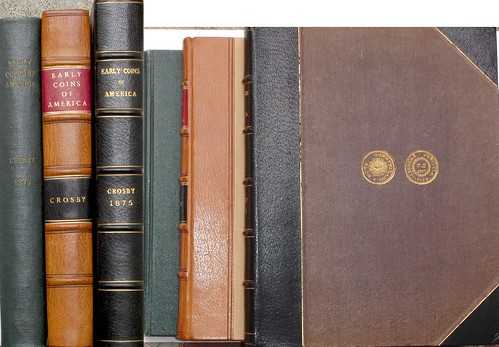
Our next mail bid sale of numismatic literature closes October 30 and will feature selections from the British token library of Allan Davisson, additional colonial research material from Michael Hodder, and selections from the library of A. Piatt Andrew, diplomat and once Director of the Mint
Perhaps the most unusual item is a set of BEP Portraits and Vignettes bound in 2 cases rather than the usual one and presented to Andrew c1910, an offering of three original Crosby Early Coins of America - one bound in the Nova Constellation cloth, and a second being the R. Green "repro-master" used to make the 1945 reprint, both with the Woodburytype plate.
A group of 8 plated Chapmans include a near mint H.P. Smith, an absolutely mint Wilson, and a rare Taylor-Windle. The Davisson library contains all three editions of Pye, two of Condor, and the rare Sharp Chetwynd. Also included are a 1913 interleaved Adams & Woodin, near complete Essay Proof Journal lacking but a single issue, and a set of the rare Greco plates of Massachusetts copper with even rarer text. To read the earlier E-Sylum article, see: DAVIS SALE OF DAVISSON AND HODDER MATERIAL CLOSES OCTOBER 30, 2010 (www.coinbooks.org/esylum_v13n38a04.html)
SKLOW TO OFFER BOWERS LIBRARY PART IV ON FEBRUARY 12, 2011
 Part IV of the Q. David Bowers Research and Source Library will lead the sale; QDB's many works on United States History, Biographies, Dictionaries and other reference works as well as several letters from Walter Breen.
Part IV of the Q. David Bowers Research and Source Library will lead the sale; QDB's many works on United States History, Biographies, Dictionaries and other reference works as well as several letters from Walter Breen.
Also included is a very special consignment the "Medals and Badges" of the American Numismatic Association from the estate of the late Rollie Finner; many rarities and many seldom if ever seen pieces a collection put together from over fifty years of collecting!
Other highlights include:
- An offering of over three thousand photographs of individual United States Large Cents in full color used by Bill Noyes in his great books.
- Some special offerings from the Rev. Russell Clunan Library.
- A long run of Chapman Auction catalogs.
- Catalog runs of many small auction companies 1930-1969
- Super Deluxe editions of the Garrett, Eliasberg and Brand auction catalogs, numbered very limited editions.
- Very Rare First edition 1881 Andrews 1816-1857 United States Large Cents
- Second edition 1883 Andrews 1816-1857 United States Large Cents.
- Clapp's work on 1798-99 Large Cents serial no. 33.
- Newcomb's 1801-02-03 Large Cent work, with scarce supplemental plate.
- Chapman's 1794 Large Cents 1926 second edition.
- Crosby's Cents of 1793 original 1897 edition with plates..
- Frossard and Hays United States Cents 1794 with plates, 1910 edition.
- Gilbert and Elder United States Cents of 1796 bound 1909 original with plates.
- Frossard and Hays United States Cents of 1794 original bound 1893 edition with plates.
- The Numismatist 1894-1936 bound volumes.
- The Numismatist 1888-1893 scarce reprint volume.
David Sklow-Fine Numismatic Books
P.O. Box 6321
Colorado Springs, CO 80934
PH: 719-302-5686
FAX: 719-302-4933
EMAIL: numismaticbooks@aol.com
WEB: FineNumismaticBooks.com
NEW BOOK: AMERICAN ART MEDALS, 1909–1995
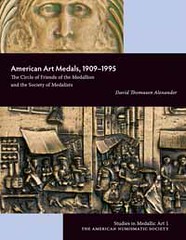 American Art Medals, 1909–1995 is the first comprehensive study of the two most important series of art medals produced in the United States: the medals of the Circle of Friends of the Medallion (1909–1915) and those of the Society of Medalists (1930–1995). Together, these two series offer an unmatched panorama of American medallic sculpture in the twentieth century.
American Art Medals, 1909–1995 is the first comprehensive study of the two most important series of art medals produced in the United States: the medals of the Circle of Friends of the Medallion (1909–1915) and those of the Society of Medalists (1930–1995). Together, these two series offer an unmatched panorama of American medallic sculpture in the twentieth century.
Founded by the art writer Charles de Kay and the collector Robert Hewitt, Jr., the Circle of Friends of the Medallion issued only twelve medals in its brief existence. Occurring, however, at a time when the Beaux-Arts movement had brought medallic art to a higher prominence among sculptors than it has enjoyed before or since, the series is of great significance for the development of the American art medal.
The Society of Medalists, during its life of sixty-six years, produced a much more extensive series: 128 regular issues (one of which includes six separate pieces), as well as four special issues designed for the Society (and one other special issue of an already existing medal). This body of work showcases the development of diverse artistic styles among figurative sculptors of the twentieth century, from classicism to modernism. The 123 sculp- tors whose work was presented in this series include almost every major American medalist of the era as well as several notable artists from other countries.
In addition to cataloguing the issues of these two medallic art organizations, this book features an innovative effort to record the different colors and patinas in which the medals were issued. Especially for the Society of Medalists, whose long history meant that different production batches of a particular medal might have been made several decades apart, this hitherto neglected dimension in the study of art medals shows how changes in the surface finish can yield truly startling variations in the visual impact of a design.
American Art Medals, 1909-1995
by David T. Alexander
hardcover, illus.
ISBN-13: 978-0-89722-317-1
List price: $150 (plus S&H)
Member price: $105 (plus S&H)
Pre-order price: $95 (plus S&H)
SPECIAL PRE-ORDER PRICE ON ORDERS PLACED BY JANUARY 15, 2011
For more information, or to order, see: www.numismatics.org/Store/ArtMedals
NEW BOOK: 1824 JR-2 - THE 6TH RAREST CAPPED BUST DIME DIE VARIETY
 My first book "1827 JR-2 - The Most Underrated Capped Bust Dime Die Variety" was printed in January, 2010. My second book "1824 JR-2 - The 6th Rarest Capped Bust Dime Die Variety" was printed in late September, 2010. Again, only 100 copies were printed. This second book will have 45 numbered pages of which 37 will have color photos. It will be softbound with Mylar covers and have a comb binding that allows you to open it and lay it flat to compare photos. Again, each specimen will be shown on a separate page with obverse and reverse photos being 4 ½" in diameter.
My first book "1827 JR-2 - The Most Underrated Capped Bust Dime Die Variety" was printed in January, 2010. My second book "1824 JR-2 - The 6th Rarest Capped Bust Dime Die Variety" was printed in late September, 2010. Again, only 100 copies were printed. This second book will have 45 numbered pages of which 37 will have color photos. It will be softbound with Mylar covers and have a comb binding that allows you to open it and lay it flat to compare photos. Again, each specimen will be shown on a separate page with obverse and reverse photos being 4 ½" in diameter.
Every known 1824 JR-2 dime, starting with the first JRCS Dime Census published in the December, 1987, John Reich Journal will be accounted for, along with several not known to John Reich Collectors Society (JRCS) members. Each specimen is ranked, starting with the finest known, an EF-45 specimen owned by John W. McCloskey down to a holed example owned by collector John Brekken.
Besides being a pictorial census of 1824 JR-2 dimes, this book includes my 25-year study on all 1824 dimes, which includes a chapter on 1824 grade distribution. There is a chapter that discusses the edges of this variety. Another chapter shows recently discovered counterfeit 1824 dimes, which makes my pedigree information even more valuable.
If you would like a copy, you can send a check or money order for $24, which includes shipping and packaging, to:
Jim Koenings
P.O. Box 2382
Riverside, CA 92516
If you would like your copy sent even sooner, you may send a payment to PAYPAL at my email address of bustcoin@verizon.net.
NEW EDITION: A CATALOG OF MODERN WORLD COINS, IN JAPANESE
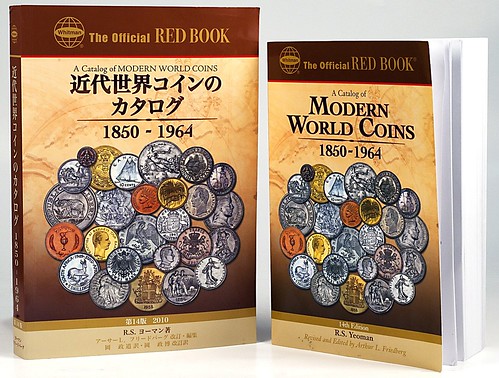
Here's one for the books—the world coin books, to be precise.
Whitman Publishing has come out with a Japanese-language edition of A Catalog of Modern World Coins, 14th edition. Aside from the obvious difference, this new version is slightly larger than the English-language edition (published in 2008), at 7 x 10 inches compared to 6 x 9, and has 504 pages compared to 544. It lists coins in Japanese alphabetical order by country (so, for example, coverage of the United States starts on page 24, instead of page 472).
In the book's foreword, Arthur Friedberg, editor of the 13th and 14th English editions, discusses the significance of this most recent Japanese-language version of Modern World Coins. Yes—“most recent”! Many readers will be surprised to learn that it's not the first of its kind.
“A book such as this edition of the Catalog of Modern World Coins demonstrates, as few other things do, the international nature of coin collecting,” writes Friedberg. “Traditionally, most collectors concentrate on the coins of their home country, and it was often thought to be a rare and adventurous breed that would turn their backs on the relatively simple and familiar and instead devote their attention to the strange and unknown, which often could not be read, much less understood.
That began to change in the middle of the 20th century when the legendary American numismatic author Richard S. Yeo (Yeoman) revolutionized the collecting of world coins as Whitman Publishing released the first edition of Modern World Coins. This was the first time that, on a large scale and at an affordable price, the average collector could handily identify and value the world's most commonly collected coins—those of the late 19th and 20th centuries.
The Yeoman numbering system remains one of the most logical ever devised for coins. By arranging the coins chronologically by their type, Yeoman was able to illustrate nearly all of them in an efficient and inexpensive format. An entire generation of collectors learned to collect by ‘Y numbers,' as dealers and auctioneers made them part of their sales lists and catalogs.
Until 1984, Modern World Coins was sold primarily in the United States, with a substantial number of books also going to Europe. A relatively modest number found their way to Japan and to the rest of Asia. By that time Richard Yeoman had retired from active numismatics and I undertook the revision of the book for its 13th edition.
Much as Yeoman did in the United States, the collecting of world coins in Japan was largely created by Masamichi Oka. I had already known and done business with Mr. Oka and his firm, Taisei Stamps and Coins, for years. He was one of the major contributors to the standard reference book, Gold Coins of the World, as well as to the new edition of Modern World Coins. The revolution he created in Japanese coin collecting was extraordinary and went in directions that Yeoman could never have envisioned in the United States.
He traveled the world making as many contacts as he could with dealers, banks, and mints. Taisei became the first to introduce and actively mass-market world coins to the Japanese public. What Oka did, which was revolutionary at the time, was to have Taisei sell not only coins—the company sold complete coin programs, highlighted by the Olympics and including many others. And Taisei did not just sell them to established collectors through the famous Taisei Monthly, but also through major department stores and within the banking system. Before long, Japan was one of the most active and exciting coin markets in the world.
Such was Masamichi Oka's vision that, in the days before email and instant communication, I still recall the day I received a letter from him proposing a Japanese edition of Modern World Coins. It did not take long for us to agree and I am proud to say that while I have hundreds of coin books in my office library, the copies of this and the companion Current Coins of the World which he inscribed to me in recognition of the work we did together are among the very few numismatic publications I keep in my home.
With the publication of the 14th edition of Modern World Coins, nothing would make Masamichi Oka prouder than to see the success his son Masahiro has had at Taisei's helm, not only in continuing the successful marketing of world coins, but also in bringing this new Japanese-language edition to fruition. As you go through the pages that follow I hope you consider this book a tribute to both of them and to a legendary numismatic family.”
It was exciting to help rejuvenate this international connection 25 years after the first Japanese-language edition. Masahiro Oka and his team were a pleasure to work with. We met several times at various American Numismatic Association shows to discuss and plan the book. The logistics were interesting—having such a large and complex manuscript translated into Japanese, figuring out the best page layout, working with specialists around the world. Publishing against the backdrop of numismatic legends like R.S. Yeoman and Masamichi Oka lent the project an air of historical importance. Art Friedberg's involvement was another bridge to the past; not only editor of the 13th and 14th editions, he was instrumental in bringing about the Japanese formats of each.
E-Sylum readers who are completists when it comes to their numismatic bibliophilism might find a worthy challenge in the Japanese-language 14th edition. Perhaps 20 copies of the book exist in the Western Hemisphere—archival and reference copies at Whitman headquarters in Atlanta. Collectors can buy theirs directly from Taisei Corporation (www.taiseicoins.com). Get a copy, have Art Friedberg and Masahiro Oka autograph it, and you've got a fine numismatic collectible with an interesting and significant story.
BOOK REVIEW: MONEY ON PAPER: BANK NOTES AND RELATED GRAPHIC ARTS
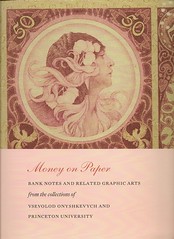 Alan Stahl, Curator of Numismatics at Princeton University kindly sent me a review copy of the catalog for the current exhibition, "Money on Paper: Bank Notes and Related Graphic Arts from the Collections of Vsevolod Onyshkevych and Princeton University," on view in the Leonard L. Milberg Gallery for the Graphic Arts, Firestone Library, Princeton University through January 2, 2011.
Alan Stahl, Curator of Numismatics at Princeton University kindly sent me a review copy of the catalog for the current exhibition, "Money on Paper: Bank Notes and Related Graphic Arts from the Collections of Vsevolod Onyshkevych and Princeton University," on view in the Leonard L. Milberg Gallery for the Graphic Arts, Firestone Library, Princeton University through January 2, 2011.
The large size 80-page softcovered catalogue contains a full list of the bank notes on display with color photographs of a few dozen of them. The notes are in excellent condition and the images are marvelous. The earlier E-Sylum included several images of notes, including a large selection of Benjamin Franklin's nature-print notes, as well as issues of Paul Revere and the South Carolina engraver Thomas Coram.
As noted earlier, one of the highlights of the exhibit is the first public display of the recently discovered banknote engraving of a grouse by wildlife illustrator John James Audubon. On display with a sample sheet containing the vignette is an original watercolor by Audubon and a steel printing plate from Audubon's Birds of America. This publication will be the first appearance in numismatic circles of the groundbreaking article by Robert Peck and Eric Newman entitled "Discovered! The First Engraving of an Audubon Bird."
The catalog would be well worth its price for the landmark Audubon essay alone, but there are two wonderful additional illustrated essays: Mark Tomasko writes on "Bank Note Engraving in the United States," and Francis Musella writes on "Benjamin Franklin's Nature Printing on Bank Notes".
Tomasko is a longtime collector and student of bank note engraving, and his essay is an excellent introduction to the topic. Francis Musella is a member of the Princeton Class of 2013. He is pursuing a degree in economics and spent his freshman year cataloging the University collection's colonial notes. It's interesting to see the juxtaposition of numismatic writing by such a young researcher together with one of field's eldest statesmen, the 99-year-old Eric Newman, who was one of the first to write about Franklin's nature printing.
Congratulations to Stahl and the exhibit's contributors - they've created not only a wonderful exhibit, but a catalog of lasting value and importance to the field.
The publication is available for $30 plus shipping from Friends of the Princeton University Library, One Washington Road, Princeton, NJ 08544. Inquiries about ordering can be made to Linda Oliveira at loliveir@princeton.edu or at (609) 258-3155.
To read the earlier E-Sylum article, see: NEW BOOK AND EXHIBIT: MONEY ON PAPER (www.coinbooks.org/esylum_v13n34a07.html)
THE BOOK BAZARRE
MORE ON THE 1852 ORMSBY SOLD BY SPINK
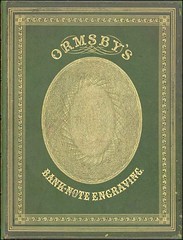 I've been a long-term collector of counterfeit detector, bank note engraving, and related material since Charlie Davis sold me a Heath pocket edition counterfeit detector at the 1991 ANA Convention in my original hometown of Chicago. Over the years I've collected literature on US counterfeit detectors and bank note reporters, original manuscripts and legal documents related to 19th century US counterfeiting, 19th century British paper money counterfeiting and prevention, and a wide range of material on bank note engraving and vignette books.
I've been a long-term collector of counterfeit detector, bank note engraving, and related material since Charlie Davis sold me a Heath pocket edition counterfeit detector at the 1991 ANA Convention in my original hometown of Chicago. Over the years I've collected literature on US counterfeit detectors and bank note reporters, original manuscripts and legal documents related to 19th century US counterfeiting, 19th century British paper money counterfeiting and prevention, and a wide range of material on bank note engraving and vignette books.
In a recent issue of The E-Sylum, you shared information on the Spink Oct. 4, 2010 sale 1022, lot 1730 offering a copy of the Ormsby book titled A Description of the Present System of Bank Note Engraving (1852). The Spink lot photograph looked familiar. After looking at my own Ormsby in possibly red unique cloth and my second copy in half-leather, there was still something oddly familiar with the lot. I called Spink to inquire about it.
Spink shared additional information including tears & loss of paper on some endpapers. Comparing images of the Ormsby in the Spink sale with the Kolbe-Adams June, 1990 auction lot 389, they look nearly identical (rebacked with specific marks on the lower front cover). While not completely assured, my conclusion is that the Spink offering was actually the original John Adams copy.
Any NBS member or E-Sylum reader who would like to correspond about the the literature of counterfeiting, counterfeit detection, and bank note engraving can contact me at numisbookmjs@gmail.com.
To read the earlier E-Sylum article, see: SPINK TO SELL RARE 1852 ORMSBY WORK SEPTEMBER 29, 2010 (www.coinbooks.org/esylum_v13n39a04.html)
BOUND FOR GLORY: EXOTIC BINDINGS IN THE ANS LIBRARY COLLECTIONS
Below is an excerpt from the online version of the exhibit. Beautiful! -Editor
Since the invention of the printing press, books have changed from massive Latin tomes, the province of the elite, to modern mass-market paperbacks, read by prince and pauper alike. The five hundred fifty years between Gutenberg and Amy Tan (author of The Kitchen God's Wife, New York Times #1 Bestseller on July 7, 1991) saw changes not just to the inside but also to the outside of books as technology and taste changed. Although the American Numismatic Society does not collect books for their fine bindings, over its 150-year history, the ANS Library has acquired a number of fine bindings. This exhibition showcases some of the finer bindings in the Library's holdings, from a sixteenth-century alum-tawed pigskin to a late-nineteenth-century binding from an Imperial Russian library.
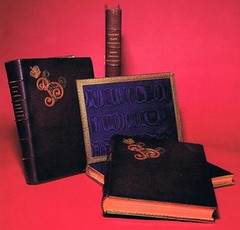 Grand Duke Georgii Mikhailovich.
Monety tsarstvovaniia (= The Corpus of Russian Coins). (12 volumes).
Grand Duke Georgii Mikhailovich.
Monety tsarstvovaniia (= The Corpus of Russian Coins). (12 volumes).
Volumes from the library of Grand Duke Vladimir Alexandrovich.
Tipografiia A. Benke, 1888-1914.
Gift of Catherine Bullowa Moore.
Binding: Fine calf leather with colored leather onlays with initials of
Grand Duke Vladimir Alexandrovich.
Inside: Gilt tooling with purple moiré silk doublures.
Other items in this exhibition include:
-- Panvinio, Onofrio. Fasti et triumphi Romanorum a Romulo Rege usque ad Carolum V. Caes. Aug. Venice, 1557.
-- Junius, Hadrian. Nomenclator omnium rerum propris nomina variis linguis explicata indicans : multo quam antea emendatior ac locupletior. Antwerp, 1583.
-- Epitome Emblematvm Panegyricorvm Academiae Altorfinae. Studiosæ Juuentuti propsita. Noriberg (Nuremburg) : Levinus Hulsius, 1602.
-- Vico, Aeneas. Augustarum Imagines aereis formis expressae… Paris, 1619.
-- Orville, Jacques Philippe d'. Sicula quibus Siciliae veteris rudera… Amsterdam, 1764.
To view the complete online exhibit, see: Bound For Glory: Exotic Bindings in the ANS Library Collections (www.numismatics.org/Library/Exhibit3Bindings)
CREATE YOUR OWN WEB SITE ON YOUR COLLECTING TOPIC
I had an exchange of emails this week with Dale Hall, whose web site was featured in last week's E-Sylum. It has brought to mind how useful it is to compile your own topical collection and put this on the web for other collectors interested in the same topic.
Dale was well along in photographing images of coins and medals in his collection of numismatic items of Austrian interest. He also -- to his credit! -- compiled a list of the artists of this collecting topic. While the coins are well documented in the Krause publications on World Coins, no such publication lists or illustrates medals and tokens which would logically fall into the same collecting topic.
I encouraged Dale to continue working on his web site. I sent him data on 26 artists from my databank who were Austrian artists who had created coins and medals of American interest, primarily portrait items of John F. Kennedy, other American presidents, and the great outpouring of medals for the Moon Landing of 1969 and American astronauts. It also included American artists who were born in Austria and came to America and created coins and medals.
How useful it would be for other collectors to do what Dale has done. Catalog and photograph your collection. Whip it into shape for a web site and put it up on the Internet. Not only will you attract interest from other collectors -- hopefully spurring some fascinating correspondence sharing mutual interest and exchanging collecting lore -- but also providing a "shopping list" of what can be included in that collecting topic.
Here are some tips:
(1) Photograph all specimens in color on a "light box." This eliminates all color background. Even if you lay a specimen on white paper it will be gray on the photo. It has to be strong white light to eliminate any background color.
(2) Prepare a "Check List" for your descriptions. Include obvious data, as obverse, reverse, edge, size, shape, composition, fineness if precious metal, artist, mint or medal maker, and such. Provide as much information as you can for each item. But don't get hung up if you can't find any one datum. Move on without it.
(3) If you enter the information on a spreadsheet you are creating an extra step for yourself. You might want to put your description in words right from the start. Spreadsheets limit your thinking to filling little boxes. Use words, sentences, paragraph and you are unlimited in how much you can write. If you already have a list in spreadsheet, convert it to words before you go online.
(4) Name every item. Put that in bold face. Put the date either before or after the name. Then you can list the rest of the information in the order of your Check List.
(5) You won't capture everything in your topic on the first attempt. Invite other collectors to inform you of what you have omitted. Collectors love to do this (human nature I guess). Don't try to list everything before before you go public. If that is your goal, you will die before you do.
(6) List only one topic for one web site. Keep it purely to that topic. I know, you collect more than one topic. Pick your favorite and create that web site first. You can always add another, and another and ....
(7) Contact me with your topic interest. Chances are I can send you something from my databank of 3,587 artists of American coins and medals. Glad to furnish you with this info. Email: dick.johnson@snet.net
(8) Once you are on the Internet, do what Dale did. Let the world know it's on the web. Tell Wayne Homren at The E-Sylum. He tells the world.
And don't forget to consider NeoCollect.com as an easy venue to manage and share your collection data. -Editor
To read the earlier E-Sylum article, see: FEATURED WEB PAGE: AUSTRIAN ENGRAVERS (www.coinbooks.org/esylum_v13n42a18.html)
DAVID LANGE ON HOBBIES MAGAZINE
A few months ago I inquired about the availability of Hobbies magazine, a publication that was popular from the 1930s through the 1960s. I was seeking copies to examine them for information and ads regarding coin boards, folders and albums. Several readers responded with possible sources, and Dave Bowers graciously loaned me a bundle of issues from the years 1934-35. My examination of these revealed no mention of anything related to coin holders of any type, and I concluded that they were just too early for the products of interest to me.
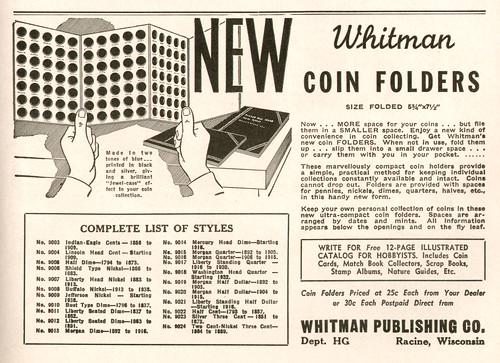
On eBay I found a nice assortment of issues ranging from 1937-50, and I purchased this lot to examine at my leisure. Since leisure time is not in abundant supply, it took me about six weeks to finally sit down with these and go through them. In the January 1942 number of Hobbies I did find a nice ad announcing the introduction of Whitman's new coin folders, the now familiar blue folders still being printed today. Though copyright dated 1940, these debuted in 1941, the year in which the January number was actually published. One or two additional Whitman ads appeared in later issues, but there was not one mention of coin boards, folders or albums in the editorial content of the issues I examined.
I've pretty much given up on Hobbies as a useful source of information for my current book project, but that's not to say that this publication is of no value to numismatists. Thomas Elder's monthly column "Recollections of an Old Coin Collector" ran for many years, and it provides some very amusing reading. Elder pulled no punches in his recall of collectors and dealers of earlier decades, nearly all of whom were no longer living to provide a rebuttal. The greatest irony is his frequent assertions of how so-and-so was far too opinionated! It would be a fun project for someone to compile all of these columns into a book, though I don't know whether the material in Hobbies is still under copyright.
As a general observation, I found that the biggest coverage in this magazine was given to antiques of all kinds and to philatelics. Stamp collecting was absolutely huge during the 1930s, due in no small part to President Roosevelt's well known love of the hobby. The philatelic section in Hobbies was typically 10-15 pages long, while numismatics was worthy of only three-four pages per month during that period.
As the 1940s progressed, this ratio actually reversed itself. Coins were slowly overtaking stamps as a hobby, though the reduced stamp coverage in Hobbies also may have reflected the simultaneous publication of periodicals devoted to that subject exclusively. In any case, it is interesting to see which hobbies occupied the minds of Americans at that time.
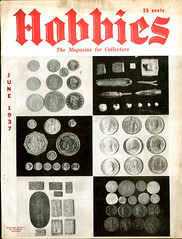
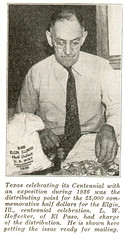
I'm attaching some illustrations scanned from various issues that may be of interest.
To read the complete article, see: MORE ON HOBBIES MAGAZINE (www.coinbooks.org/esylum_v13n30a10.html)
THE BOOK BAZARRE
NOVEMBER 18, 2010 AUCTION SALE HIGHLIGHTSRare Bowersiana
Including the First Two Coin Publications Issued by Q. David Bowers and Deluxe Bound Editions of the Combined Garrett Sales and the Combined Norweb Sales, Both Prepared Solely for Presentation Purposes and Issued in Editions Limited, Respectively, to 40 and 20 Copies, Signed by Bowers
141 W JOHNSTOWN ROAD, GAHANNA OH 43230-2700
(614) 414-0855 • df@numislit.com • GFK@numislit.com
A CONTEMPORARY ACCOUNT OF THE 1851 ROPER SALE
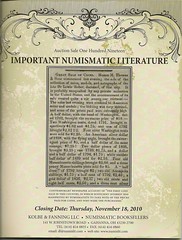 Regarding the Kolbe & Fanning numismatic literature sale #119 coming up on November 18th, 2010, Joel Orosz writes:
Regarding the Kolbe & Fanning numismatic literature sale #119 coming up on November 18th, 2010, Joel Orosz writes:
My hardbound K&F catalog arrived this week, and my eye was immediately caught by the account of the Roper Sale on the cover. How cool is that? You may well be single-handedly responsible for starting a whole new genre in numismatic literature collecting!
My copy of the sale arrived this week, too. I was equally pleased with the sale cover - that lot is from my consignment of newspapers with numismatic content, and K&F chose one of my favorite items in the collection, a contemporary account of the 1851 sale of the coin collection of Dr. Lewis Roper. I have a handpriced copy of the catalog in my library (Mark Collet's copy).
Joel wrote a great article for the January 2001 issue of The Numismatist titled "Dr. Lewis Roper: Argonaut of the Numismatic Realm" The Roper sale was a landmark event in American numismatic history. From Joel's article:
If one were to choose a single date on which everything changed in American numismatics, it surely would be February 20, 1851. Before that, coins appeared at auction in the United States only infrequently, and always as a "tag on" to sales of books, jewelry or artwork. ... American coins- indeed, the whole coin hobby - were strictly small potatoes until 1851.
Then came the Dr. Lewis Roper sale. It was the first U.S. auction in which coins were the main event .. and the first that attracted numismatists from faraway cities. The catalog had to be reprinted to meet the demand of interested bidders. When the dust settled, it was the first U.S. coin auction to clear more than $1,000, then considered a remarkably high sum.
The Roper sale was not merely an auction, it was an event. Not only did home-town Philadelphia coin hounds like Joseph J. Mickley, Jacob Giles Morris and Richard Wistar Davids attend, but the leading numismatic lights of other cities made the trek as well: Charles Ira Bushnell of New York City, Jeremiah Colburn of Boston, and even Dr. Ammi Brown of Salem, Massachusetts.
Cataloguer David Fanning kindly sent me the text for the lot description:
Lot 349 THE BARRE PATRIOT. Vol. VII, No. 36 (Friday, Mar. 21, 1851). Barre, Massachusetts: Published by Charles E. Stevens. Tabloid. 4 pages. Leaves separated neatly at spine. Very good. (250.00)
Page 4 of this issue includes a highly important and interesting account of the auction sale of the Dr. Lewis Roper collection (M. Thomas & Sons, Feb. 20–21, 1851), which Emmanuel J. Attinelli would later describe as “the first coin sale in this country, in which sufficient interest was manifested by numismatists to take note of the prices paid for coins, and who were the purchasers.” The article, about 9 column inches in length, is extensive, and gives many prices for items sold. The article notes that “The actual value in metal, of the lot of American coins, scarcely exceeded $10, and yet they brought about $66.” The article reports only on the portion of the sale containing the American coins and medals, many of the highlights of which are mentioned. Very rare.
Joel Orosz adds:
You were ahead of your time in collecting historical newspapers.
Well, I had competition and didn't get every item I went after. But what I've enjoyed about collecting numismatic ephemera of all types is threefold - the thrill of the hunt, the ultimate discovery of significant items, and their high rarity. Ephemeral items like newspapers were meant to be used and thrown away, and most were. The Roper catalog itself is an extreme rarity in numismatic literature, but I wouldn't be surprised to learn that newspaper accounts like this are even more rare. I've never seen nor heard of another.
Last week I discussed a few of my other favorite items from the collection, including contemporary accounts of new Fugio Cents and 1794 Dollars.
To read the earlier E-Sylum article, see: NUMISMATIC GLEANINGS FROM CONTEMPORARY NEWSPAPERS (www.coinbooks.org/esylum_v13n42a11.html)
WHITMAN BALTIMORE EXPO EDUCATIONAL HIGHLIGHTS
David Crenshaw of Whitman sent me a copy of the press release for the upcoming Whitman Coin & Collectibles Baltimore Expo. He writes:
A few noteworthy highlights are:
- Q. David Bowers: The ANA and Me. The legendary numismatist, whose involvement dates to his first bourse table in 1955, will talk about what the organization has meant to him.
- An exhibit marking the 10th anniversary of the Sacagawea Dollar
- A special presentation by Odyssey Marine Exploration about shipwreck coin treasures
- "Shipwreck! Pirates and Treasure," a multi-media exhibit housed at the Maryland Science Center on Baltimore's Inner Harbor
Shipwreck, pirates and sunken treasure are among the highlights when the Whitman Coin & Collectibles Baltimore Expo opens here on Thursday, November 4 continuing through Sunday, November 7 in Hall A of the Baltimore Convention Center at One West Pratt Street. It will include more than 1,000 dealers.
 Q. David Bowers: The ANA and Me.
Q. David Bowers: The ANA and Me.
The legendary numismatist, whose involvement dates to his first bourse table in 1955, will talk about what the organization has meant to him. By special arrangement with the ANA and Stack's, a deeply discounted membership fee opportunity will also be included.
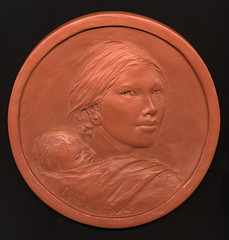 Sacagawea Dollar Exhibit
Sacagawea Dollar Exhibit
An exhibit marking the 10th anniversary of the Sacagawea Dollar will also be a centerpiece of the Expo. It will include Glenna Goodacre's original "Terra Cotta Coin Study," a preliminary bas-relief that dates to 1999.
Shipwrecks
The compelling stories of some of the world's most famous shipwrecks, their treasure of historic artifacts and the buccaneers who plied the sea lanes during the age of sale are the topic of a special presentation by Odyssey Marine Exploration on Friday, November 5 at 11:30am.
Shipwreck! Pirates and Treasure, a multi-media exhibit housed at the Maryland Science Center on Baltimore's Inner Harbor-just a short walk from the bourse floor-includes artifacts from a number of shipwrecks along with high-definition video and photographs from numerous deep sea sites. Registered dealers will each receive a voucher good for admission to the exhibit on November 5 from 2pm until 8pm.
"Our coin dealers are a group of people who know and love their history. By teaming up with Odyssey and the Maryland Science Center, we're pleased that we can give each dealer the chance to see this fascinating exhibit with artifacts that are certain to be of interest," Expo General Manager David Crenshaw said.
Mr. Crenshaw said a mini-display of artifacts will be at the Expo throughout. Members of Odyssey's staff will answer questions both at the 11:30 presentation and at the main exhibit at the Science Center.
For more information, see: whitmanexpo.com
CALL FOR PAPERS: 2011 MEMPHIS INTERNATIONAL PAPER MONEY SHOW
Call for Papers
Memphis Speakers Series
2011 Memphis International Paper Money Show
June 10-12, 2011
The speaker series was a big hit and major draw at Memphis 2010. The program for Memphis 2011 is going to be even better!
We'll be commemorating the 50th anniversary of both the Society of Paper Money Collectors and International Bank Note Society.
We invite presentations on any fiscal paper or fiscal paper tie-in topic. We expect a packed program so submit your proposal early to ensure your place in it. Deadline for submissions is March 1st so we have time to do a good job with press releases, scheduling, and preparation of the show program.
Format: Talks are scheduled on the hour throughout the show. Each talk is allotted 50 minutes, which includes time for questions. Speakers arrive 10 minutes before the hour for setup.
We encourage talks that are lavishly illustrated so most speakers present Powerpoint presentations loaded on their own laptops. We simply plug your laptop into the digital projection system, and you are ready to go with all of your special fonts and whistles and bells that you build into your presentation.
A very successful experiment was tried in 2010 in which speakers give a presentation and set up a parallel exhibit in the exhibition area. This allowed people who attended the talk to see the actual objects. The exhibit also served to advertise the talk.
Application requirements:
(1) lists of presenter(s) and full contact information for each,
(2) title of talk,
(3) catchy concise newsworthy description of the content of your talk - this will be your primary draw,
(4) special equipment needs such as a slide projector or number of cases if you plan to bring show-and-tell items.
Submit your applications by the March 1st deadline preferably by e-mail to peterhuntoon@embarqmail.com or by mail to Speaker Series Chairman Peter Huntoon, P. O. Box 60850, Boulder City, NV 89006.
THE BOOK BAZARRE
QUERY: 2010 WINTER OLYMPICS MEDALS INFORMATION SOUGHT
Regarding last week's item on the 1968 Olympic medal being offered for sale, Ginger Rapsus writes:
Speaking of Olympic medals, does anyone have information on the medals from the 2010 Winter Olympics? Is it true that each one had a different design? I am working on an article on Canadian coins with a hockey theme, and I want to mention the 2010 Winter Olympics. A number of Chicago Blackhawks players took part in the games

To read the earlier E-Sylum articles, see:
DESIGNING THE 2010 WINTER OLYMPIC MEDALS
(www.coinbooks.org/esylum_v13n07a21.html)
MAKING THE 2010 OLYMPIC MEDALS AT THE ROYAL CANADIAN MINT
(www.coinbooks.org/esylum_v13n07a22.html)
MORE ON THE 2010 WINTER OLYMPIC MEDALS
(www.coinbooks.org/esylum_v13n08a15.html)
QUERY: MEDAL OF THE MONTH FOUNDATION
I saw a medal that caught my eye while reading Dick Hanscom's Alaskan Token Collector newsletter this week (October 2010 issue). Dick kindly sent me images of the piece.
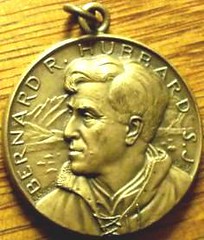
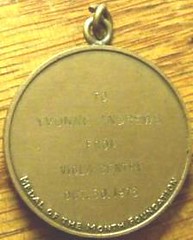
Here's the description of the piece:
Rev. Bernard Hubbard, S.J. was a former head of the geology department of the University of Santa Clara, California. Known as the "Glacier Priest," he led 31 scientific expeditions to Alaska and the Arctic. The medal; was issues by the "Medal of the Month Foundation." Bronze, 32mm, with loop.
So here's my question: just what was the Medal of the Month Foundation? Was it a real organization or just a marketing gimmick? Does it still exist?
The reverse is engraved, but neither of us can make out much beyond " To Yvonne ... From ..."
DUANE FEISEL ON PRICES AND VALUES IN NUMISMATIC BOOKS
Regarding our earlier discussion of prices, values, and rarity in numismatic books Duane H. Feisel writes:
The attached file provides my approach to whether to use price or rarity in a numismatic listing catalog. The answer is neither – value is the key as argued in the attached. This approach was used in my Token and Medal Society Mishler gold medal awarding-winning catalogs of California Encased and Sticker Coins and of Pre-Prohibition California Saloon tokens.
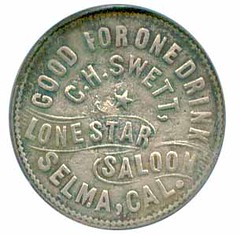 It is the age-old question. The one thing that most everyone – collector, trader, buyer, seller – wants to know. “What's it worth?” That question is behind every transaction whether it be a sale, trade or purchase. There is only one answer: value is what a willing buyer (or trader) will pay to a willing seller (or trader). While that isn't really very helpful to most people, it is the real answer to “What's it worth?”
It is the age-old question. The one thing that most everyone – collector, trader, buyer, seller – wants to know. “What's it worth?” That question is behind every transaction whether it be a sale, trade or purchase. There is only one answer: value is what a willing buyer (or trader) will pay to a willing seller (or trader). While that isn't really very helpful to most people, it is the real answer to “What's it worth?”
Some token catalogs attempt to provide a rarity rating (the number of pieces known to exist) and then relate rarity to value. However, except for a catalog of the most limited scope, it must be recognized that a rarity rating is at best an educated guess. How can the cataloger possibly poll every collector (and non-collector) to create a census for every item in the catalog? That is an impossible task.
Even if a fairly accurate rarity can be established, is there really any direct connection between rarity and value? Often, not. Say there is a modern wooden nickel that has been misprinted – only one example exists, so it would be of the highest rarity – it's unique. The only way this item would have any value at all is if there is a demand for it. How many collectors would be interested in a modern misprinted wooden nickel? Probably not very many. The point is, rarity by itself means very little. Demand must be considered.
What are some of the factors that affect demand? There probably are as many different approaches to collecting anything as there are collectors interested in a specific item for whatever reason. The number of people wanting a specific item is the demand. Still, demand itself is but one factor in trying to come up with a value.
Perhaps “Desirability Factor” (DF) is what we are looking for. The higher the Desirability Factor, the more valuable the item for a given rarity and demand. Many different considerations result in the final DF – and the buyer and the seller may have different opinions of what constitutes desirability. These opinions may be termed “perceived value.”
The Desirability Factor (DF) is what eventually determines value. The buyer mentally develops his “perceived value,” and the seller also mentally develops his own “perceived value.” Perhaps a sale or trade is consummated when the buyer mentally perceives a value higher than the value perceived by the seller.
This catalog provides an Estimated Value for each item that is fully listed. This EV is based on a piece in average circulated condition.
The Estimated Value (EV) attempts to take into account the Desirability Factors that may apply to the item. It is anticipated that perhaps 80% of the sales of an item will be within the price range of the EV – sometimes toward the high end, sometimes toward the low end. The value location within the EV range will depend on the weights given to the various desirability factors that affect value in the minds of the buyer and the seller – “perceived value.” Indeed, there may be sales outside the EV range when the buyer and seller both agree that, for whatever reason, the item has a lower or greater perceived value.
Complicated? Perhaps. There really is no simple answer.
Realistic? Certainly. Isn't this what really happens when a collectible item changes hands?
To read the earler E-Sylum article, see: MORE ON PRICES AND VALUES IN NUMISMATIC BOOKS (www.coinbooks.org/esylum_v13n41a12.html)
MIKE KLIMAN AND ABE KOSOFF
Alan V. Weinberg writes:
Myron "Mike" Kliman of Laguna Niguel, accused and arrested for cutting his neighbor's hand with a knife over a pine needle dispute, is the one time son-in-law of legendary numismatic dealer Abe Kosoff and was married for quite a period to Abe's daughter Sonny Kliman. Both have since divorced and been re-married.
As indicated in an E-Sylum article some time back, Mike is one of the 4 or 5 remaining living American attendants to the 1954 Cairo King Farouk lot viewing and auction where he accompanied Abe and Sonny. I have seen a group photo of Abe and family at the sale.
Mike related to me the story of Abe whispering to Mike to examine an auction lot of $5 half eagles in the sale: "Shush, see this one? - it's a Moffat pioneer $5 gold piece".
To read the earlier E-Sylum article, see: TWO-CENT PIECE AUTHOR KLIMAN ARRESTED (www.coinbooks.org/esylum_v13n42a13.html)
NOTES FROM E-SYLUM READERS: OCTOBER 24, 2010
Michael E. Marotta writes:
Former Mensa member Ginger Rapsus cautioned that the word "Mensa" is not "an acrostic." I would say "acronym." NASA is an acronym. An acrostic is more involved, typically using (from the Greek) a line of verse or any sentence and can employ any regular pattern of letters, such as first, third, or last. Edgar Allen Poe's "Valentine" to Joan of Arc is an acrostic: first letter of the first line; second letter of the next; etc.
I am not a dealer, and not much of a collector of stuff. Like Walter Breen, I collect knowledge. Like Dick Johnson, I have some interest in codes, but unlike Walter Breen, I am not impressed with my own intelligence, but rather, daunted by the lack of it. My code is for convenience: I write the buy price twice, as letters. A=1, B=2, etc. For a coin that cost $51, I write EAZY.
Jeffrey Zarit writes:
Dennis Tucker writes:
Here's an interesting article in the New York Times about the hobby community for sea glass --- and some reactions and opinions concerning fakes. Could the Chinese counterfeiters be far behind?
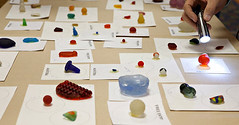 They and hundreds of other enthusiasts gathered here this month for the annual meeting of the North American Sea Glass Association, to celebrate a hobby that seems an odd mix of amateur archaeology, environmental monitoring and antique collecting, with a little chemistry thrown in.
They and hundreds of other enthusiasts gathered here this month for the annual meeting of the North American Sea Glass Association, to celebrate a hobby that seems an odd mix of amateur archaeology, environmental monitoring and antique collecting, with a little chemistry thrown in.
At the meeting they trade shards of glass and porcelain, buy and sell sea glass jewelry and crafts, seek expert help identifying their finds and hear presentations on shipwrecks, the glass industry and other topics.
Membership is growing and enthusiastic, Mary Beth Beuke of Sequim, Wash., the group's president, said in an interview, and sales of sea glass and its crafts are booming, even though the glass itself “is getting harder to find.”
Though sea glass collectors talk about bottles, porcelain and other cargo lost in shipwrecks, most sea glass originated far more prosaically, in garbage dumped into the ocean or piled in coastal landfills. A blue shard may be the remains of a Noxzema jar or a bottle of Bromo-Seltzer; old Coke and beer bottles produce pale-green and dark-brown shards. Now this kind of dumping is mostly a thing of the past; bottles are made of thinner glass, and plastic has replaced glass in many products.
But sea glass hunters do not necessarily limit themselves to glass. Some look for crockery shards, bottle stoppers, fragments of old toys, marbles — virtually anything that left human hands to be tumbled by the sea.
To read the complete article, see: From Junk to Collectible, Shaped by Time and Tide (www.nytimes.com/2010/10/19/science/19glass.html)
SO ... WHATEVER HAPPENED TO BERNARD VON NOTHAUS?
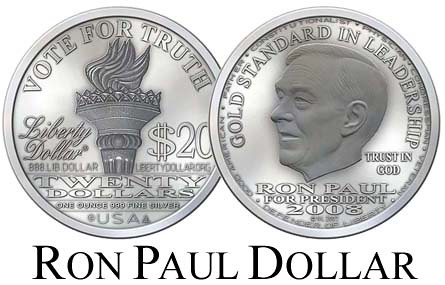
After receiving my copy of Numismatic News in yesterday's mail, I immediately turned to the Letters and Viewpoint section to see what the readers are saying to find a Viewpoint article: “Private ‘Coins' Should be Collected.” In the article, Will Gragg writes that Liberty Dollar issued by the National Organization for the Repeal of the Federal Reserve (NORFED) should be collected. Aside that the article seems like a thinly veiled support for the Liberty Dollar, I began to wonder what happened to Bernard von NotHaus.
Bernard von NotHaus was a co-founder of the Royal Hawaiian Mint. He served as the mint's supervisor before leaving and founding NORFED under the premise that the Federal Reserve is illegal and devaluing U.S. money by issuing fiat money. Believing that he could create currency using precious metals that could be used in trade, von NotHaus created the Liberty Dollar. NORFED marketed their “coins” as “Real Money” and that their associated notes are “America's Inflation Proof Currency.”
In 2006, the U.S. Mint issued a consumer alert warning that the Liberty Dollar is not legal tender. Von NotHaus and coconspirators were arrested in 2007 by the FBI. He was release on bond. A grand jury handed down indictments against von NotHaus and his coconspirators for primarily violating 18 U.S.C. § 486, for “Uttering [circulating] coins of gold, silver or other metal.”
Von NotHaus was arrested on June 30, 2010 for violating the terms of his bond. After appearing before Judge David S. Cayer, Federal District Court for the Western District of North Carolina in Charlotte on Wednesday, July 14, von NotHaus's bond was revoked and is in federal prison pending trial.
It was difficult to find information on the status of von NotHaus. Reports about his arrest and incarceration did not appear in the “mainstream media.” This news was found by reading other sources that reported von NotHaus's arrest at the beginning of August.
According to the court's calendar, the case of USA v. von NotHaus, et. al. (5:09-cr-00027-RLV-DCK-1) was scheduled for a hearing today (October 19) before Judge Richard Voorhees. No public information about the hearing was available at the time this was written.
Justice moves slowly.
To read the complete blog article, see: Whatever Happened to Bernard von NotHaus (coinsblog.blogspot.com/2010/10/whatever-happened-to-bernard-von.html)
To read one of the last E-Sylum articles on the topic, see: GOVERNMENT IS SUED OVER SEIZURE OF LIBERTY DOLLARS (www.coinbooks.org/esylum_v11n26a25.html)
THE BOOK BAZARRE
“United States Coinage: A Study by Type.”COINTELEVISION INTERVIEWS COIN AND MEDAL ARTIST ALEX SHAGIN
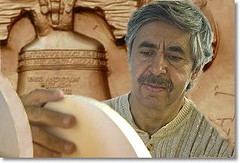
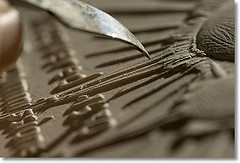
Alex Shagin was born in Russia, near Leningrad, on January 21, 1947. Alexander George Shagin is the only child of George and Ekaterina Shagin. He studied at the Vera Mukhina School of Arts and Design, completing his education in 1971.
In the 1970's the Leningrad mint was involved mostly in the production of medals and commemorative coins. Shagin was responsible to produce at least one medal every two months. Although he was allowed a rather wide latitude in his work, all of his designs had to be approved by the Council of Art medals before they could be struck.
Shagin applied for an exit visa. This so angered the Soviet officials that he was immediately relieved of his position. After waiting more than a year, during which time he had no means of earning a living, he was finally given an exit visa. In 1979 Shagin emigrated to the United States and now resides in Santa Monica, California where he continues his art.
He has works in museums and private collections around the world, including the Hermitage Museum, the Smithsonian Institution, Yad Vashem Museum, the British Museum and the Swedish Royal Medallic Collection. In 2002, as First Vice President of the American Medallic Sculpture Association (A.M.S.A.) he participated in the Federation Internationale de le Medaille (F.I.D.E.M.) congress by designing a special presentation medal for the American Delegation–The Medal of Liberty presented to twelve individuals by Ronald Reagan in 1986.
To read the complete article, see:
Profiles: Medal and Coin Artist Alex Shagin
(www.coinlink.com/News/general-collecting/
profiles-medal-and-coin-artist-alex-shagin/)
U.S. GOLD COIN HOARD FOUND IN EAST LONDON GARDEN
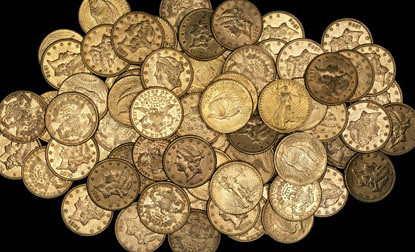
A valuable hoard of American gold coins has been unearthed in an east London garden — one of Britain's most curious treasure finds.
Buried hoards are discovered every so often, but their Anglo-Saxon, Viking or Roman owners were themselves interred long ago. Whoever hid the 80 coins from the 19th and early 20th centuries may be alive. Why they chose the garden of a residential block in Hackney is a mystery.
Archaeologists more used to deciphering which Roman emperor is depicted on a coin have been taken aback by the find — gold $20 “Double Eagle” pieces dating from 1854 to 1913 and minted mostly in San Francisco and Philadelphia. Estimates put the value at hundreds of thousands of pounds. The coins, so large that each one weighs 33 grams, go on show at the Museum of London tomorrow.
They were uncovered by two residents who decided to do gardening with a couple of friends. A spade hit something hard. Expecting to remove a brick or a rock, they found themselves staring at glistening gold. One finder, interested in archaeology, alerted the Museum of London, which contacted the Portable Antiquities Scheme at the British Museum.
Scheme head Dr Roger Blandtold the Standard: “There is a huge mystery about who might have buried the coins. It's wonderful to speculate. Who buries so many gold coins?”
Today Inner North London coroner Dr Andrew Scott Reid, announcing the find, said the original owner had until next spring to come forward. The finders are remaining anonymous and the find's location is not being released to discourage false claims. An ill-gotten gain has to be possible and police records are being checked.
To read the complete article, see:
Hackney gardeners dig up hoard of American gold coins
(www.thisislondon.co.uk/standard/article-23888665
-golden-double-eagle-hoard-dug-up-in-a-hackney-garden.do)
On Wednesday Philip added:
Roger Bland, Head of Portable Antiquities Scheme (PAS) has forwarded me this press release giving a lot more detail. They are withholding some information, such as container (if any) and burial site, to help confirm if any claimant is genuine.
The whole group is currently on display in the British Museum (room 41) and not Museum of London, as reported by the Evening Standard. I saw them today and took some photographs. I only photographed the coins themselves; they were part of a display about the portable antiquities scheme.
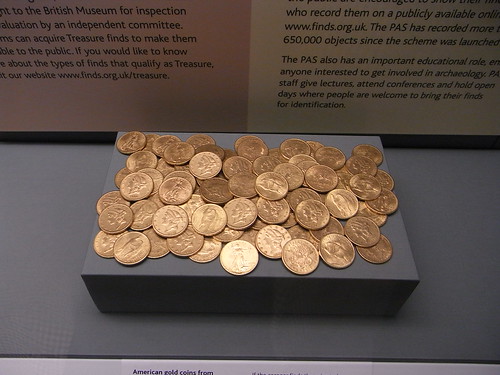
Anyone with any information about the original owners of the coins, their heirs or successors, should provide this to the Treasure Registrar, the British Museum. The Museum will require evidence about how, when, where and why the coins were concealed and evidence upon which they can be sure of the ownership by any potential claimant.
Dr Barrie Cook of the British Museum (Department of Coins and Medals) reports:
“The 80 coins are all gold 20-dollar pieces of the United States, issued between 1854 and 1913. The coins are thus all the same denomination, introduced in this form in 1850, and were struck to the same standard, 90% gold, used from 1837 until the end of US gold coinage in 1933. The catalogue shows that the coins gradually increase in number across the decades from 1870 to 1909 (13 coins from 1870-9; 14 from 1880-89; 18 from 1890-99; and 25 from 1900-9). Over a quarter of the total were issued in the last 6 six years represented. Together these factors suggest that the material began to be put aside during this later period, rather than being built up systematically across a range of time represented. The main element among this latest material are the 17 coins dating to 1908, which suggests that a single batch of coins from that year might have formed the core for the group.”
A catalogue of the hoard runs as follows:
| Date | Mint | Total number in find |
| 1854 | San Francisco | 1 |
| 1867 | San Francisco | 1 |
| 1870 | San Francisco | 1 |
| 1875 | Carson City | 1 |
| 1875 | San Francisco | 1 |
| 1876 | San Francisco | 5 |
| 1876 | Philadelphia | 2 |
| 1877 | San Francisco | 2 |
| 1877 | Philadelphia | 1 |
| 1881 | San Francisco | 1 |
| 1882 | San Francisco | 2 |
| 1883 | San Francisco | 3 |
| 1884 | San Francisco | 2 |
| 1885 | San Francisco | 1 |
| 1888 | San Francisco | 4 |
| 1889 | San Francisco | 1 |
| 1890 | Philadelphia | 1 |
| 1891 | San Francisco | 1 |
| 1893 | San Francisco | 1 |
| 1894 | San Francisco | 4 |
| 1896 | San Francisco | 3 |
| 1898 | San Francisco | 4 |
| 1899 | San Francisco | 4 |
| 1900 | San Francisco | 2 |
| 1901 | San Francisco | 3 |
| 1902 | San Francisco | 2 |
| 1905 | San Francisco | 2 |
| 1907 | Philadelphia | 1 |
| 1908 | Philadelphia | 17 |
| 1909 | Philadelphia | 1 |
| 1910 | Philadelphia | 1 |
| 1913 | Philadelphia | 3 |
| 1913 | Denver | 1 |
BRITAIN'S NEW STEEL 5P AND 10P COINS CALLED A 'DISASTER'
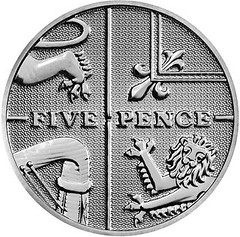 Britain's 5p and 10p coins are to be substantially changed next year, causing potential chaos for the millions of people using vending machines and parking meters.
Britain's 5p and 10p coins are to be substantially changed next year, causing potential chaos for the millions of people using vending machines and parking meters.
The changes, which involves the coins being made from a different metal and becoming thicker, have never been officially announced by either the Royal Mint or the Treasury. Some experts have told The Daily Telegraph the change is a "disaster" and they are becoming increasingly alarmed the new coins will fail to work in hundreds of thousands of machines, and that the costs of implementing changes will run to as much as £100 million.
The "silver" 5p and 10p coins have always been made from a metal known as cupronickel, an alloy made of 75 per cent copper, 25 per cent nickel. Indeed, all shillings, which preceded the 5p coin, were made from cupronickel following the end of World War II.
However, from January 1 next year they will be made from steel, with a nickel coating. In most respects they will look identical and weigh the same, but sharp-eye observers will notice they will be 11 per cent thicker, moving from 1.7mm in depth to 1.9mm.
They will also become magnetic for the first time.
However, while most shoppers and schoolchildren receiving their pocket money might not notice the difference, nearly all vending machine and parking meters will. Office workers buying a cup of coffee or someone in a rush to park their car could suddenly find their money – perfectly legal tender – is not accepted.
Jonathan Hilder, the chief executive of the Automatic Vending Machine Association, whose members service 500,000 vending machines in Britain, said: "We've told the Treasury and The Royal Mint that this is going to be a disaster, but they haven't taken notice.
"It's meant to be a money saving exercise, but this will cost the vending industry £42 million and the coin machine industry as a whole possibly as much as £100 million."
The problem comes about because tea and chocolate dispensers, as well as parking meters are sophisticated machines designed to detect fraudulent coinage. They test each coin by shape, weight as well as its electromagnetic composition.
All machines will have to have their software updated, and in most instances, need to be recalibrated to recognise both the new coins and the old ones, which will continue to be in circulation for at least a decade.
While the Royal Mint has given the industry a few samples of the new coins, they have not provided final production versions, making it impossible to start changing the machines. The industry said it does not have enough engineers to undertake the overhaul in less than four months.
To read the complete article, see:
New steel 5p and 10p coins a 'disaster'
(www.telegraph.co.uk/finance/personalfinance/consumertips/
banking/7979997/New-steel-5p-and-10p-coins-a-disaster.html)
MORE ON THE ROYAL MINT'S DATELESS TWENTY PENCE
A SINGLE mum could pocket £14,000 after discovering two rare 20p coins – including one given in her change after buying a LOSING lottery scratchcard.
The Royal Mint produced the dateless coinage in 2008 and only a limited number are now in circulation.
Yet pregnant Birmingham mum Sabrina Hussain has managed to find TWO of the rare pieces – which have previously sold on internet auction site eBay for £7,100 each.
One was given to her in change after buying a losing scratchcard – and she discovered the other in the bottom of her handbag.
Sabrina, 22 and from Winson Green, said: “I saw a story in the paper about a year ago about these rare 20p pieces.
“I emptied my handbag then and found the first one at the bottom, but decided against selling straight away.
“Then a couple of weeks ago I was at a corner shop buying a scratchcard and there was another undated 20p in my change. I couldn't believe it, the scratchcard didn't win, but I'd got another rare coin! It was amazing.
“I went back into the store and told all the staff who were gutted that they hadn't found it. But I was over the moon.”
Last year one of the rare dateless coins sold on eBay for £7,100.
“I may sell one but I may also keep the other until my daughter is 18 – just imagine what it might be worth then.”
But expert Dave Harris from Birmingham Coins, based in Acocks Green, said Sabrina should sell the two 20p pieces now while they are popular.
“My advice would be to put these up on eBay and let people bid for them on the internet,” he said.
“There's no guarantee how much these will be worth in the future, if anyone could tell that they'd be a millionaire.
“But my opinion is that these coins are valuable because they have had an air of mystery about them created by publicity, and that now is as good a time as any to cash in.”
And Peter Viola, an expert numismatist from the Warwick Antiques Centre, said: “She should strike now while the iron is hot.
“The best way to get value for money is to put them up for sale on the internet, because a lot of dealers have been overwhelmed with them.”
To read the complete article, see:
Pregnant Birmingham mum finds 20p coins which could fetch £14,000
(www.sundaymercury.net/news/midlands-news/2010/10/24/
pregnant-birmingham-mum-finds-20p-coins-
which-could-fetch-14-000-66331-27532452/)
To read the earlier E-Sylum article, see: THE CRAZE FOR THE ROYAL MINT'S DATELESS 2009 TWENTY PENCE (www.coinbooks.org/esylum_v12n28a22.html)
SCOTTISH MINISTER PUSHING ACCEPTANCE OF BANKNOTES IN ENGLAND
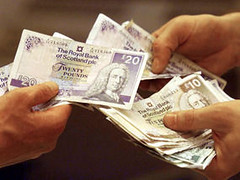 ENGLISH shopkeepers could be forced to take Scottish banknotes in time for the Christmas spending spree, it was revealed yesterday.
ENGLISH shopkeepers could be forced to take Scottish banknotes in time for the Christmas spending spree, it was revealed yesterday.
Scottish notes are not technically seen as legal tender south of the Border, with individual retailers having the right to refuse them.
Many fear Scots notes are forgeries and reject them automatically despite high-tech counter gadgets proving they are genuine.
But Scottish Office minister David Mundell – the country's only Tory MP – is trying to strike a deal to end the problem. Mr Mundell, who represents Dumfriesshire, Clydesdale and Tweeddale, also wants all auto-tills at car parks, supermarkets and rail stations to accept Scottish money.
He has instructed Government officials to examine the possibility of bringing in new laws to put Scottish notes on the same footing as English ones.
To read the complete article, see: NEW HOPE IN BANKNOTE BATTLE (www.express.co.uk/posts/view/206081)
COULD A RUSTY COIN RE-WRITE CHINESE-AFRICAN HISTORY?
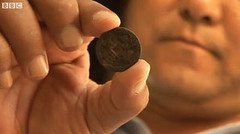 It is not much to look at - a small pitted brass coin with a square hole in the centre - but this relatively innocuous piece of metal is revolutionising our understanding of early East African history, and recasting China's more contemporary role in the region.
It is not much to look at - a small pitted brass coin with a square hole in the centre - but this relatively innocuous piece of metal is revolutionising our understanding of early East African history, and recasting China's more contemporary role in the region.
A joint team of Kenyan and Chinese archaeologists found the 15th Century Chinese coin in Mambrui - a tiny, nondescript village just north of Malindi on Kenya's north coast.
In barely distinguishable relief, the team leader Professor Qin Dashu from Peking University's archaeology department, read out the inscription: "Yongle Tongbao" - the name of the reign that minted the coin some time between 1403 and 1424.
"These coins were carried only by envoys of the emperor, Chengzu," Prof Qin said.
"We know that smugglers would often take them and melt them down to make other brass implements, but it is more likely that this came here with someone who gave it as a gift from the emperor."
And that poses the question that has excited both historians and politicians: How did a coin from the early 1400s get to East Africa, almost 100 years before the first Europeans reached the region?
The answer seems to be with Zheng He, also known as Cheng Ho - a legendary Chinese admiral who, the stories say, led a vast fleet of between 200 and 300 ships across the Indian Ocean in 1418.
Until recently, there have only been folk tales and insubstantial hints at how far Zheng He might have sailed.
Then, a few years ago, fishermen off the northern Kenyan port town of Lamu hauled up 15th Century Chinese vases in their nets, and the Chinese authorities ran DNA tests on a number of villagers who claimed Chinese ancestry.
The tests seemed to confirm what the villagers have always believed - that a ship from Zheng He's fleet sank in a storm and the surviving crew married locals, meaning some people in the area still have subtly Chinese features.
It was then that Peking University organized its expedition to try to find conclusive evidence. The university is spending $3 million (£2 million) on the three-year project.
While the evidence is still not conclusive, it undermines Portuguese explorer Vasco Da Gama's claim to have been the first international trader to open up East Africa.
He arrived in 1499 on an expedition to find a sea route to Asia, and launched more than 450 years of colonial domination by European maritime powers.
To read the complete article, see: Could a rusty coin re-write Chinese-African history? (www.bbc.co.uk/news/world-africa-11531398)
Via Facebook, Martin Purdy adds:
The only problem with this theory is that I believe the "Yongle tongbao" coins were all made retrospectively, i.e. none were actually produced during the 1403-24 period covered by the reign title. I'd need to re-check the details but I understood they were produced at a later date to "fill the gap" at the request of a subsequent emperor, and then became an incredibly popular coin that was imitated throughout Asia and as far away as Java.
I picked up numerous examples in Japan in the 1980s, one of which was attributed to Java because of its metal content. Traders may well have taken them to East Africa, but I suspect it would have been well after the 15th century, and probably not Chinese traders either, given the ban on ocean-going vessels in later years.
THE PUBLIC CAN'T KEEP ITS HANDS OFF THIS STATUE
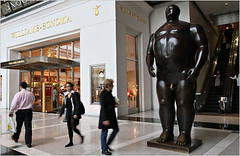 The other day, Glyna Aderhold, a retired 67-year-old real estate broker from Nashville, was crossing the lobby of the mall at the Time Warner Center, the soaring castle of commerce and culture at Columbus Circle, when she passed a monumental bronze sculpture of a man and saw something that made her pause.
The other day, Glyna Aderhold, a retired 67-year-old real estate broker from Nashville, was crossing the lobby of the mall at the Time Warner Center, the soaring castle of commerce and culture at Columbus Circle, when she passed a monumental bronze sculpture of a man and saw something that made her pause.
“I walked up and I was looking at his head and boom! This thing hits me right in the face,” Ms. Aderhold said.
The thing was the statue's genitals, which are uncovered and at eye level to the adult viewer. She was being metaphorical. They didn't actually strike Ms. Aderhold in the face. But they could have.
Ms. Aderhold kept walking, but all day long, shoppers and tourists alike stop at the bubble-figured 12-foot-tall Adam by the Colombian artist Fernando Botero that greets visitors and provides perhaps the most memorable Manhattan meeting spot since the clock in the Biltmore Hotel. And when they stop, they often touch, grasp, pat or rub the statue's small but prominent penis, while a friend or relative takes a photo.
Most of Adam is a deep dark brown; his penis, though, is worn golden from extensive handling.
This is a maintenance issue at the mall. “We have an art dealer that comes in and redoes the patina from time to time,” said David Froelke, the center's general manager, “but it doesn't last very long.”
Around the world and throughout history, of course, people have rubbed statues for luck, from Abraham Lincoln's nose in Illinois to Lou Costello's shoe in Paterson, N.J., to the snout of the Porcellino boar in Florence to various parts of the charging bull of Wall Street.
Within half an hour on a late September afternoon, Adam's organ drew a steady stream of visitors. First Graciela Fabres, 26, of West New York, N.J., parked her stroller and held her hand beneath the penis, palm up, as if presenting merchandise on “Let's Make a Deal,” while her husband took her picture. A fiftysomething woman with blond hair and workout clothes grabbed it appraisingly, shook her head with a slight scowl, and walked on.
To read the complete article, see:
An Attention-Getter, Irresistibly Interactive
(cityroom.blogs.nytimes.com/2010/10/21/
an-attention-getter-irresistibly-interactive/)
FEATURED WEB SITE: METALS USED IN COINS AND MEDALS
This week's Featured Web Site is suggested by John and Nancy Wilson, who write:
The site is a great source for information on "Metals Used in Coins and Medals by Tony Clayton. We found it while researching porcelain coins and medals.
This page details the various metals and alloys that have been used for coins and medals over the centuries.
When I was at University I gave a talk to the college Science Society on the subject, and it is also of interest to me as my first job involved carrying out research into alloys of such exotic materials as niobium, hafnium, tantalum, zirconium and titanium for superconducting, chemical and aeronautical applications.
We also had some gallium, but somebody left it above a radiator and it melted!
Some (but by no means all) of the information came out of 'The Teach Yourself Guide to Numismatics' by C.C.Chamberlain published in 1960, and I also wish to acknowledge the help of many correspondents on the newsgroup rec.collecting.coins.
www.cartage.org.lb/en/themes/arts/
scultpurePlastic/NumismaticsSigillography/
CoinsThroughHistory/MetalsUsed/MetalsUsed.htm
